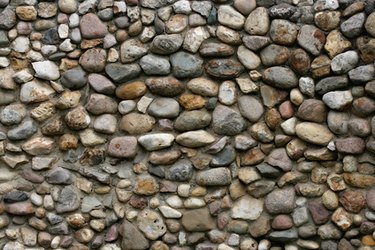Things You'll Need
Concrete masonry unit foundation
Tape measure
Creek rock fascia stones
Creek rock corner stones
Portland cement
Masonry sand
Polymer-modified thinset compound
Water
Large bucket or wheelbarrow
Masonry trowel
Grout bag
Thin wire brush

A foundation with large exposed areas can be unsightly. Fortunately, the concrete cinder block typically used in home foundations makes an ideal substrate for an applied rock fascia. Using creek rock fascia stones, you can make it look like your home is resting on a foundation of natural stone. The installation process is very similar to that of setting wall tile, except you have more freedom in how you arrange the fascia stones to get the look you want.
Step 1
Estimate the amount of fascia stone to be used. For each wall, measure the length and height of each exposed wall, and multiply the two figures to estimate the amount of square footage of facia stone to order. If the exposed wall is on a steep grade, take 1/2 the maximum height times the length.
Video of the Day
Step 2
Estimate the linear feet of corner stones needed by measuring the length of exposed corners. Since each linear foot of corner also covers about 3/4 foot of flat wall space, you'll need to take the total linear feet of corners, multiply it by 0.75 and subtract that amount from the flat wall space to get the actual amount of flat wall stones you need.
Step 3
Mix the adhesive coat. Mix 2 parts Portland cement, 1 part thinset and 5 parts masonry sand in a large bucket or wheelbarrow. Add enough water so that the mixture is easy to work, but sticks to the trowel when it's set on edge.
Step 4
Working in small areas, apply a thin coat of mortar to the foundation wall, starting from a lower corner. Apply only to an area small enough so that you can set fascia stones into it before it hardens.
Step 5
Apply the fascia stones to the mortar. Because creek rock is irregularly shaped, you have a lot of latitude on how you set the stones up. However, to make the wall look authentic, you should try to arrange the stones so they are no more than 1/2 to 1 inch away from each other.
Step 6
Allow the adhesive layer to set, usually 12 to 24 hours.
Step 7
Mix the grout. Mix 2 parts Portland Cement to 7 parts masonry sand, with enough water so that it has about the same consistency as the adhesive coat.
Step 8
Load some of the grout into the grout bag and twist the bag closed at the top.
Step 9
Squeezing from the back of the bag, apply the grout to the spaces between the fascia stones.
Step 10
Press the grout into the stone joints as it is beginning to set, using the back of the wire brush.
Step 11
Wipe any chunks of grout off the surface of the stones with the wire brush. Do not allow the grout to set on the stones themselves.
Tip
There are many styles of creek rock fascia stones to choose from. If your building is near a lake or river, try to choose a fascia style that matches the stones near the water for a more authentic look. You may wish to apply external insulation to the foundation wall before you install the fascia. If so, check with the manufacturer's installation instructions on how to prepare the insulated wall for the stone fascia. You can add concrete colorants to your grout mixture to get nearly any kind of look you want, from simple gray to white or rust colored. If your adhesive coat or grout won't stick to the wall, it's probably too wet. Add some more sand to thicken it.
Warning
These installation instructions apply only to manufactured creek rock fascia stones, not to actual rocks. Real rocks are much heavier, and require the installation of a wire mesh layer, attached to the foundation at several points, before the rock is applied. Failure to do so may result in stones falling off the wall. Be careful not to apply too much adhesive coat to the foundation at any one time. If the mortar sets up too much before you get a chance to set stones in it, you'll have to scrape it off and start over.
Video of the Day